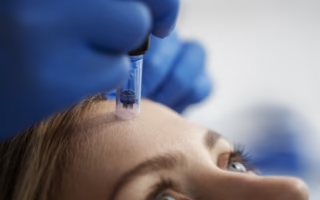Exosome therapy is gaining attention in the skincare and haircare world as a cutting-edge treatment for anti-aging, rejuvenation, and hair restoration. But while the benefits are promising, many readers wonder: “Is exosome therapy really safe?” or “What side effects should I expect?”
In this guide, we’ll break down everything you need to know about exosome therapy safety, possible side effects, and precautions so you can make an informed decision before trying it.
🔍 Why Talk About Safety in Exosome Therapy?
Since exosomes are bioactive messengers derived from stem cells, they have a powerful effect on skin regeneration and inflammation. While they’re considered less risky than surgical procedures, it’s important to understand both the short-term and long-term safety profile before starting therapy.
👉 If you’re new to this topic, check out our detailed guide:
- [Exosome Therapy for Skin & Hair: Complete 2025 Guide]
- [What Are Exosomes in Skincare? Benefits Explained]
✅ General Safety of Exosome Therapy
Most clinical and cosmetic dermatology studies suggest that exosome therapy is generally safe when performed by qualified professionals using high-quality, medical-grade exosomes.
- Non-invasive application: Usually paired with microneedling, lasers, or injections.
- No live cells: Unlike stem cell therapy, exosomes don’t replicate, lowering risks of unwanted growth.
- Minimal downtime: Redness and swelling often resolve within 24–48 hours.
According to a 2023 dermatology review in the Journal of Clinical Medicine, exosome-based treatments have shown promising results with low incidence of adverse effects when properly administered.
⚠️ Possible Side Effects of Exosome Therapy
While rare, side effects can occur, especially if the therapy is poorly regulated or performed by untrained practitioners.
1. Short-Term Side Effects
- Mild redness, swelling, or bruising at the injection/microneedling site
- Temporary tightness or warmth on the skin
- Mild itching or sensitivity
2. Rare or Severe Reactions
- Allergic response to exosome preparation (very uncommon)
- Infection risk if tools are not sterilized
- Inconsistent results due to poorly sourced exosomes
3. Long-Term Concerns
Currently, long-term safety data is still limited, as exosome therapy is relatively new in cosmetic dermatology. Most reports suggest benefits last 6–12 months, but continuous studies are ongoing.
🧑⚕️ Who Should Avoid Exosome Therapy?
Exosome therapy may not be recommended for:
- Pregnant or breastfeeding women
- Individuals with autoimmune disorders or severe skin conditions (unless cleared by a doctor)
- People prone to keloid scarring
- Patients with active infections or open wounds on the treatment area
Always consult a board-certified dermatologist before undergoing the procedure.
🏥 How to Ensure a Safe Exosome Treatment
- Choose a licensed clinic or dermatologist with experience in regenerative medicine.
- Ask about the source of exosomes (preferably from FDA-compliant, clinical-grade labs).
- Avoid “DIY exosome kits” or unverified products sold online.
- Follow proper aftercare instructions to minimize risk of infection or irritation.
For further safety guidance, the American Academy of Dermatology recommends choosing evidence-based treatments from certified providers.

❓ FAQs About Exosome Therapy Safety
Currently, cosmetic exosome products are not officially FDA-approved, but many labs provide exosomes manufactured under FDA-compliant practices for research and clinical use.
No evidence suggests that exosome therapy causes cancer. Unlike stem cells, exosomes cannot replicate. Still, long-term monitoring is ongoing.
These combinations are generally safe and often enhance results, but they may increase temporary redness and sensitivity.
Most side effects (if any) appear within the first 24 – 72 hours and resolve quickly.
Yes, exosomes are typically well-tolerated across all skin types, but a patch test or consultation is recommended for sensitive skin.
🧾 Final Thoughts
Exosome therapy is one of the most exciting innovations in modern dermatology, offering powerful skin and hair rejuvenation with minimal risks. While most people only experience mild and temporary side effects, the quality of the clinic, practitioner, and exosome source plays a huge role in safety.
If you’re considering exosome therapy, start by reading:
- [Exosome Therapy for Skin & Hair: Complete 2025 Guide]
- [What Are Exosomes in Skincare? Benefits Explained]
✨ Next Step: Always consult a qualified dermatologist before booking exosome therapy, and never settle for cheap or unverified treatments.
👩⚕️ About GlowNest Care Team
At GlowNest Care, our mission is simple to cut through the hype and bring you honest, science-backed skincare insights you can trust. From emerging treatments like exosome therapy to timeless natural remedies, our experts research the facts so you can make confident choices for your skin.
📖 Read More: Explore our latest skincare tips, haircare routines, mani-pedi care guides, overall beauty care advice, weekly glow tips, FAQs on trending topics, and handy beauty calculators to keep your glow strong.
🔗 Share This Post: Found it helpful? Share it with friends, family, or on social media to spread the knowledge and inspire healthier skin.
💬 Join the Discussion: Have questions or experiences to share about your skincare routine? Drop your thoughts in the comments, we’d love to hear from you!



